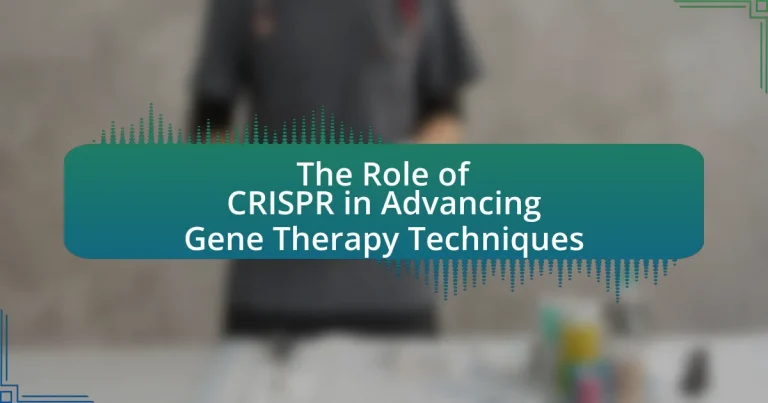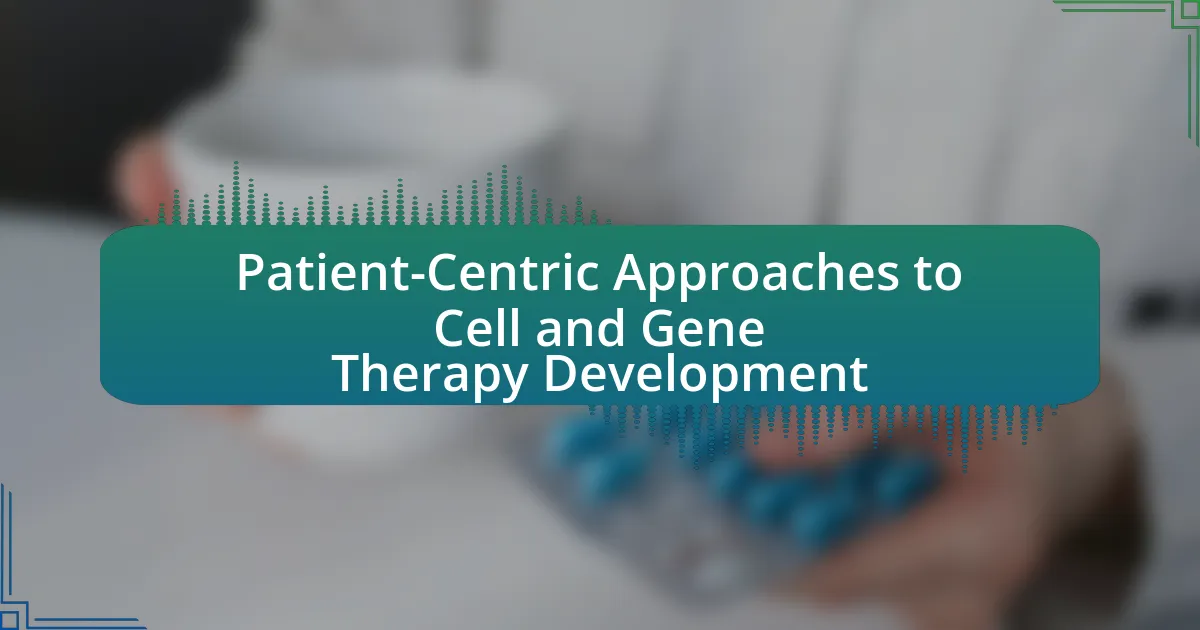CRISPR technology is a pivotal advancement in gene therapy, enabling precise editing of genetic sequences to correct mutations linked to various diseases. This article explores the mechanisms of CRISPR, including the roles of the Cas9 protein and guide RNA in gene editing, and highlights its applications in treating genetic disorders such as sickle cell disease and muscular dystrophy. Additionally, it addresses the advantages of CRISPR over traditional gene therapy methods, the ethical considerations surrounding its use, and the future prospects for CRISPR in advancing therapeutic techniques. The discussion encompasses the challenges faced in cancer therapy and the importance of responsible research practices to ensure safe and effective applications of CRISPR technology.
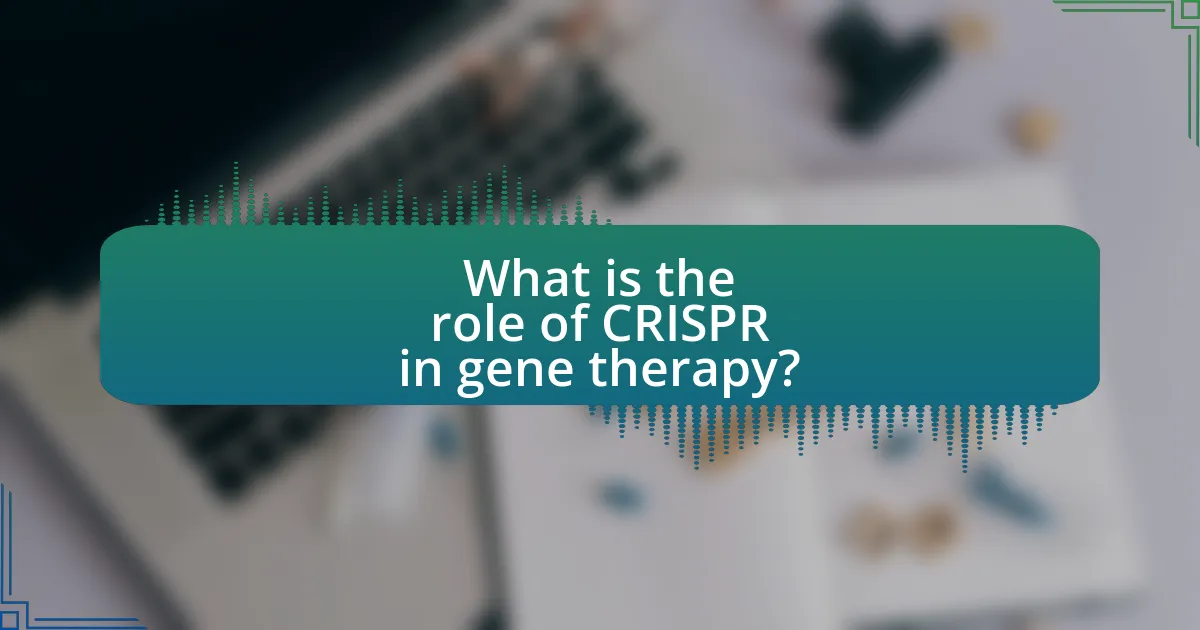
What is the role of CRISPR in gene therapy?
CRISPR plays a crucial role in gene therapy by enabling precise editing of genetic sequences to correct mutations responsible for diseases. This technology allows for targeted modifications in the DNA of living organisms, which can lead to the treatment or potential cure of genetic disorders. For instance, studies have demonstrated that CRISPR can effectively eliminate the genetic mutations causing conditions like sickle cell anemia and muscular dystrophy, showcasing its therapeutic potential. The ability to make specific changes in the genome with high efficiency and accuracy positions CRISPR as a transformative tool in the field of gene therapy.
How does CRISPR technology function in gene editing?
CRISPR technology functions in gene editing by utilizing a guide RNA to direct the Cas9 enzyme to a specific DNA sequence, where it creates a double-strand break. This targeted break allows for the disruption of genes or the insertion of new genetic material through cellular repair mechanisms, such as non-homologous end joining or homology-directed repair. The precision of CRISPR is evidenced by its ability to edit genes with high specificity, as demonstrated in studies where it successfully modified genes in various organisms, including plants and animals, with minimal off-target effects.
What are the key components of the CRISPR system?
The key components of the CRISPR system are the Cas9 protein, guide RNA (gRNA), and the target DNA sequence. The Cas9 protein acts as a molecular scissors that cuts DNA at specific locations, while the guide RNA directs Cas9 to the precise site in the genome by complementary base pairing with the target DNA. This mechanism allows for targeted gene editing, which has been demonstrated in various studies, including research published in “Science” by Doudna and Charpentier in 2012, establishing the foundational understanding of CRISPR technology.
How does CRISPR achieve precise gene modifications?
CRISPR achieves precise gene modifications through a mechanism that utilizes a guide RNA to direct the Cas9 nuclease to a specific DNA sequence, where it creates a double-strand break. This targeted approach allows for the introduction of desired genetic changes during the DNA repair process, either by inserting new genetic material or by correcting mutations. The precision of CRISPR is validated by its ability to recognize specific sequences with high fidelity, as demonstrated in studies showing that CRISPR can achieve targeted edits with minimal off-target effects, making it a powerful tool in gene therapy.
Why is CRISPR considered a breakthrough in gene therapy?
CRISPR is considered a breakthrough in gene therapy because it allows for precise, targeted editing of the genome, significantly improving the ability to correct genetic disorders. This technology utilizes a guide RNA to direct the Cas9 enzyme to specific DNA sequences, enabling the modification or removal of faulty genes. Studies have demonstrated CRISPR’s effectiveness in treating conditions such as sickle cell disease and beta-thalassemia, with clinical trials showing promising results in patients. The simplicity, efficiency, and cost-effectiveness of CRISPR compared to previous gene-editing methods further solidify its status as a transformative tool in the field of gene therapy.
What advantages does CRISPR offer over traditional gene therapy methods?
CRISPR offers several advantages over traditional gene therapy methods, primarily its precision, efficiency, and cost-effectiveness. Unlike traditional methods that often rely on viral vectors to deliver genes, CRISPR utilizes a guide RNA to target specific DNA sequences, allowing for more accurate modifications with minimal off-target effects. Studies have shown that CRISPR can edit genes in a matter of hours, significantly faster than conventional techniques, which can take weeks or months. Additionally, the cost of CRISPR technology is substantially lower; estimates suggest that CRISPR can reduce the cost of gene editing by up to 90% compared to older methods, making it more accessible for research and therapeutic applications.
How has CRISPR changed the landscape of genetic diseases treatment?
CRISPR has revolutionized the treatment of genetic diseases by enabling precise gene editing, which allows for the correction of mutations at specific locations in the genome. This technology has facilitated advancements in therapies for conditions such as sickle cell disease and muscular dystrophy, where traditional treatments were limited. For instance, a study published in the journal Nature in 2020 demonstrated that CRISPR-based therapies could effectively eliminate the genetic mutations responsible for sickle cell disease in patient-derived cells, leading to the restoration of normal hemoglobin production. This level of precision and efficiency in targeting genetic defects marks a significant shift from earlier gene therapy methods, which often relied on less accurate techniques.
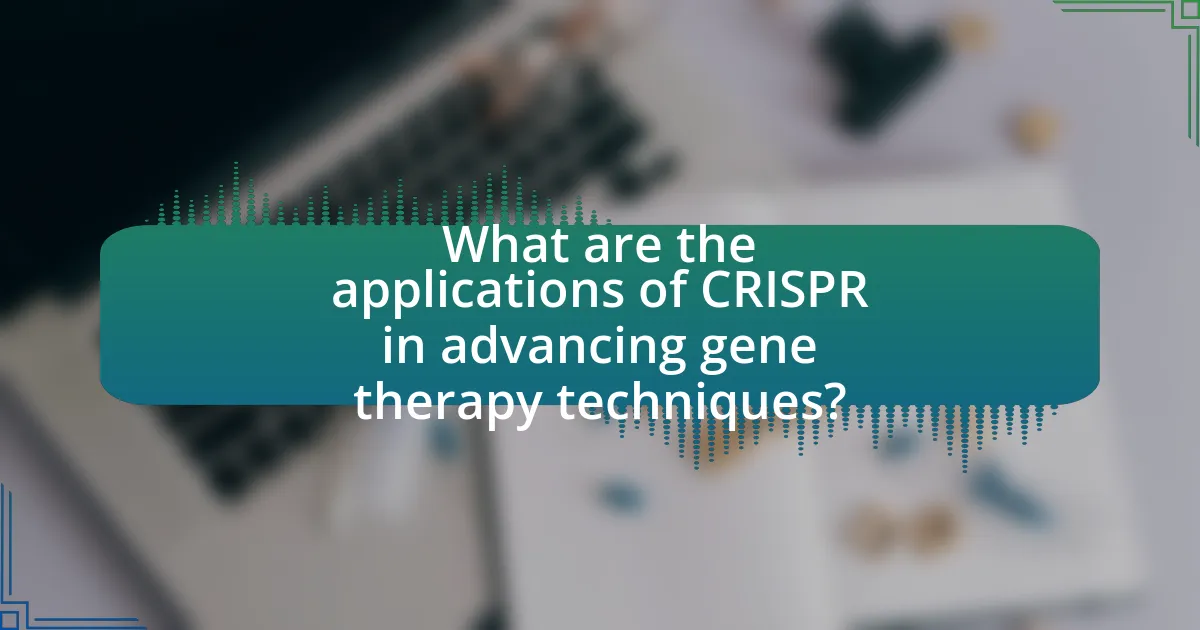
What are the applications of CRISPR in advancing gene therapy techniques?
CRISPR is applied in gene therapy techniques primarily for precise gene editing, allowing for the correction of genetic mutations responsible for diseases. This technology enables targeted modifications in the DNA sequence, which can effectively treat conditions such as sickle cell disease and cystic fibrosis. For instance, a study published in the New England Journal of Medicine demonstrated that CRISPR-based therapies could successfully edit the genes of patients with sickle cell disease, leading to significant clinical improvements. Additionally, CRISPR is utilized in developing personalized medicine approaches, where therapies are tailored to the genetic profile of individual patients, enhancing treatment efficacy and reducing side effects.
How is CRISPR used in treating genetic disorders?
CRISPR is used in treating genetic disorders by enabling precise editing of DNA to correct mutations responsible for these conditions. This technology allows scientists to target specific genes, making alterations that can potentially cure or alleviate symptoms of genetic diseases. For instance, in clinical trials, CRISPR has been applied to treat conditions like sickle cell disease and beta-thalassemia by modifying hematopoietic stem cells to produce healthy red blood cells. Research published in the New England Journal of Medicine demonstrated that patients with these disorders showed significant improvement after receiving CRISPR-based therapies, validating the effectiveness of this gene-editing approach in addressing genetic disorders.
What specific genetic disorders have been targeted using CRISPR?
CRISPR has been used to target specific genetic disorders such as sickle cell disease, beta-thalassemia, Duchenne muscular dystrophy, and cystic fibrosis. For instance, in clinical trials, CRISPR has successfully edited genes in patients with sickle cell disease and beta-thalassemia, leading to the production of healthy red blood cells. Research published in the New England Journal of Medicine demonstrated that CRISPR-based therapies can effectively correct the genetic mutations responsible for these disorders, showcasing the potential of CRISPR in gene therapy.
What are the success rates of CRISPR in clinical trials for genetic disorders?
The success rates of CRISPR in clinical trials for genetic disorders vary, with reported efficacy rates ranging from 30% to over 90% depending on the specific condition being treated. For instance, a study published in 2021 demonstrated a 90% success rate in patients with sickle cell disease after CRISPR-based therapy. Additionally, trials targeting conditions like beta-thalassemia have shown similar high efficacy, indicating that CRISPR is a promising tool in gene therapy for genetic disorders.
What role does CRISPR play in cancer therapy?
CRISPR plays a crucial role in cancer therapy by enabling precise gene editing to target and modify cancer-related genes. This technology allows researchers to disrupt oncogenes, which promote cancer cell growth, or to restore the function of tumor suppressor genes that are often mutated in cancer. For instance, studies have demonstrated that CRISPR can effectively knock out genes responsible for drug resistance in cancer cells, enhancing the efficacy of existing treatments. Additionally, clinical trials are exploring CRISPR’s potential to engineer immune cells to better recognize and attack cancer cells, showcasing its transformative impact on personalized cancer therapies.
How does CRISPR enhance the effectiveness of cancer treatments?
CRISPR enhances the effectiveness of cancer treatments by enabling precise gene editing to target and modify cancer-related genes. This technology allows for the disruption of oncogenes, which drive cancer growth, and the activation of tumor suppressor genes, thereby inhibiting tumor progression. For instance, studies have demonstrated that CRISPR can effectively knock out genes responsible for drug resistance in cancer cells, making them more susceptible to chemotherapy. Additionally, CRISPR can be used to engineer immune cells, such as T cells, to better recognize and attack cancer cells, as evidenced by research published in Nature Biotechnology, which showed improved anti-tumor responses in modified T cells.
What challenges does CRISPR face in cancer gene therapy?
CRISPR faces several challenges in cancer gene therapy, including off-target effects, delivery mechanisms, and ethical concerns. Off-target effects occur when CRISPR inadvertently edits unintended parts of the genome, potentially leading to harmful mutations. A study published in Nature Biotechnology highlights that these unintended edits can complicate the therapeutic outcomes and safety of CRISPR applications in cancer treatment. Additionally, effective delivery of CRISPR components to tumor cells remains a significant hurdle, as current delivery methods, such as viral vectors, can be inefficient or provoke immune responses. Lastly, ethical concerns regarding germline editing and the potential for misuse of CRISPR technology in humans pose significant barriers to its widespread acceptance and application in cancer gene therapy.
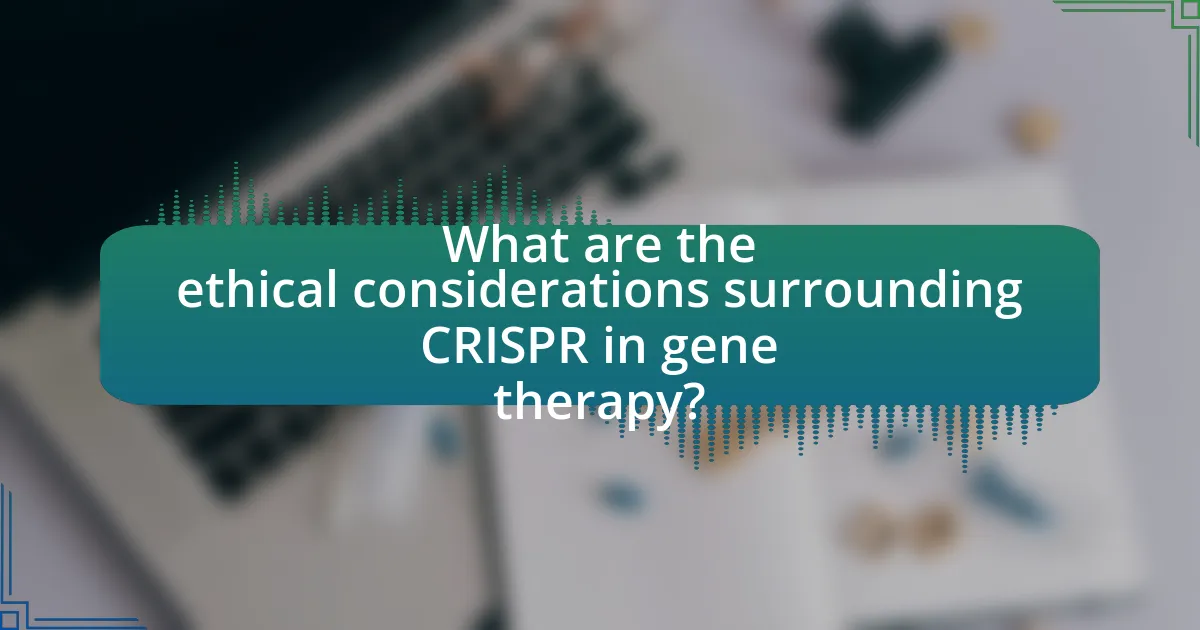
What are the ethical considerations surrounding CRISPR in gene therapy?
The ethical considerations surrounding CRISPR in gene therapy include concerns about safety, consent, equity, and potential long-term effects on the human gene pool. Safety issues arise from the possibility of off-target effects, where unintended genetic modifications could lead to harmful consequences. Informed consent is crucial, especially when dealing with germline editing, as future generations may be affected without their knowledge or agreement. Equity concerns highlight the risk of exacerbating social inequalities, as access to advanced gene therapies may be limited to wealthier populations. Additionally, the potential for “designer babies” raises moral questions about the extent to which humans should manipulate genetic traits. These considerations are underscored by ongoing debates in bioethics and regulatory frameworks, emphasizing the need for responsible governance in the application of CRISPR technology.
What ethical dilemmas arise from CRISPR technology?
CRISPR technology presents several ethical dilemmas, primarily concerning genetic modification, consent, and potential misuse. Genetic modification raises concerns about “designer babies,” where parents might select traits for their children, leading to social inequality and discrimination based on genetic characteristics. Consent issues arise particularly in germline editing, where changes affect future generations who cannot consent to the modifications made. Additionally, the potential for misuse of CRISPR in creating biological weapons or enhancing human capabilities poses significant ethical risks. These dilemmas highlight the need for robust ethical frameworks and regulations to guide the responsible use of CRISPR technology in gene therapy.
How do regulations impact CRISPR research and applications?
Regulations significantly impact CRISPR research and applications by establishing guidelines that govern the ethical use, safety, and efficacy of gene editing technologies. These regulations, enforced by governmental bodies such as the U.S. Food and Drug Administration (FDA) and the European Medicines Agency (EMA), dictate the approval processes for clinical trials and the commercialization of CRISPR-based therapies. For instance, the FDA requires comprehensive preclinical data demonstrating safety and efficacy before allowing human trials, which can delay research timelines and increase costs. Additionally, regulations address ethical concerns, such as germline editing, which is restricted in many jurisdictions due to potential long-term implications on human genetics. This regulatory framework ensures that CRISPR applications are developed responsibly, balancing innovation with public safety and ethical considerations.
What are the public perceptions of CRISPR in gene therapy?
Public perceptions of CRISPR in gene therapy are largely mixed, with significant concern about ethical implications and potential risks. A 2021 survey by the Pew Research Center found that 72% of Americans believe gene editing could lead to unintended consequences, reflecting apprehension about safety and long-term effects. Additionally, 61% of respondents expressed concern about the potential for gene editing to be used for non-medical enhancements, indicating a fear of “designer babies.” These perceptions highlight a cautious approach among the public, balancing the potential benefits of CRISPR technology in treating genetic disorders against ethical dilemmas and societal impacts.
How can researchers ensure responsible use of CRISPR in gene therapy?
Researchers can ensure responsible use of CRISPR in gene therapy by adhering to strict ethical guidelines and regulatory frameworks. These guidelines include conducting thorough risk assessments to evaluate potential off-target effects and unintended consequences of gene editing. For instance, the National Institutes of Health (NIH) and the World Health Organization (WHO) have established protocols that emphasize the importance of transparency, informed consent, and public engagement in research processes. Additionally, researchers should collaborate with interdisciplinary teams, including ethicists and legal experts, to navigate the complex implications of gene editing technologies. By following these practices, researchers can mitigate risks and promote the safe application of CRISPR in therapeutic contexts.
What best practices should be followed in CRISPR research?
Best practices in CRISPR research include thorough validation of CRISPR constructs, careful design of guide RNAs, and rigorous off-target analysis. Validating CRISPR constructs ensures that the intended genetic modifications are achieved without unintended consequences. Designing guide RNAs with high specificity minimizes off-target effects, which can lead to unwanted mutations. Conducting off-target analysis is essential to confirm that the CRISPR system does not affect unintended genomic sites, thereby maintaining the integrity of the organism’s genome. These practices are supported by studies demonstrating that careful design and validation significantly enhance the safety and efficacy of CRISPR applications in gene therapy.
How can transparency and public engagement improve CRISPR applications?
Transparency and public engagement can significantly improve CRISPR applications by fostering trust and collaboration between scientists and the community. When researchers openly share their methodologies, findings, and ethical considerations, it demystifies the technology and encourages informed public discourse. For instance, initiatives like public forums and educational outreach have been shown to enhance understanding and acceptance of gene editing technologies, as evidenced by studies indicating that informed communities are more likely to support scientific advancements. Furthermore, engaging the public in discussions about potential risks and benefits allows for diverse perspectives, which can lead to more responsible and socially acceptable applications of CRISPR in gene therapy.
What are the future prospects of CRISPR in gene therapy?
The future prospects of CRISPR in gene therapy are highly promising, with advancements expected to enhance precision and efficacy in treating genetic disorders. Ongoing research indicates that CRISPR technology can be refined to improve delivery mechanisms, reduce off-target effects, and increase the range of treatable conditions. For instance, studies have demonstrated successful applications of CRISPR in correcting mutations responsible for diseases like sickle cell anemia and muscular dystrophy, showcasing its potential for widespread therapeutic use. Furthermore, the development of next-generation CRISPR systems, such as CRISPR/Cas9 and CRISPR/Cas12, is anticipated to expand the toolkit available for gene editing, making it more versatile and applicable to a broader array of genetic conditions.
How might CRISPR evolve in the next decade?
CRISPR is likely to evolve significantly in the next decade through advancements in precision, efficiency, and application scope. Researchers are developing next-generation CRISPR systems, such as CRISPR-Cas12 and CRISPR-Cas13, which offer improved targeting capabilities and reduced off-target effects, enhancing gene editing accuracy. Additionally, innovations in delivery mechanisms, like nanoparticles and viral vectors, are expected to facilitate more effective and safer gene therapy applications. The ongoing exploration of CRISPR’s potential in treating complex diseases, including cancer and genetic disorders, is supported by studies demonstrating its efficacy in preclinical models. For instance, a 2021 study published in Nature demonstrated CRISPR’s ability to correct genetic mutations in human cells, paving the way for clinical trials. These advancements indicate that CRISPR will play a crucial role in the future of gene therapy, expanding its therapeutic potential and accessibility.
What innovations are on the horizon for CRISPR technology?
Innovations on the horizon for CRISPR technology include advancements in base editing, prime editing, and the development of CRISPR-based diagnostics. Base editing allows for precise nucleotide changes without double-strand breaks, significantly reducing off-target effects, as demonstrated in research published in Nature by David Liu and colleagues. Prime editing, introduced in 2019, offers the potential to correct up to 89% of known genetic diseases with high accuracy, as shown in studies by the Broad Institute. Additionally, CRISPR-based diagnostics, such as SHERLOCK and DETECTR, enable rapid and sensitive detection of pathogens, which has been crucial during the COVID-19 pandemic, according to research from the Broad Institute and MIT. These innovations are set to enhance the efficacy and safety of gene therapy techniques significantly.
What practical tips can be applied when utilizing CRISPR in gene therapy?
When utilizing CRISPR in gene therapy, it is essential to ensure precise targeting of the desired gene to minimize off-target effects. This can be achieved by employing advanced bioinformatics tools to design guide RNAs that are specific to the target sequence, thereby reducing the likelihood of unintended edits. Additionally, optimizing delivery methods, such as using viral vectors or lipid nanoparticles, enhances the efficiency of CRISPR components reaching the target cells. Research indicates that using a combination of Cas9 and a single-guide RNA (sgRNA) can improve editing accuracy, as demonstrated in studies like those published in Nature Biotechnology, which highlight the importance of careful design and testing of CRISPR systems for therapeutic applications.
How can researchers optimize CRISPR experiments for better outcomes?
Researchers can optimize CRISPR experiments for better outcomes by carefully designing guide RNAs, selecting appropriate delivery methods, and employing rigorous validation techniques. Effective guide RNA design enhances target specificity and reduces off-target effects, which is crucial for achieving precise gene editing. Studies have shown that using algorithms for guide RNA design can significantly improve editing efficiency, as evidenced by a 2016 study published in Nature Biotechnology, which demonstrated that optimized guide RNAs led to a 50% increase in on-target editing rates.
Additionally, choosing the right delivery method, such as electroporation or viral vectors, can influence the efficiency of CRISPR components reaching the target cells. For instance, a 2020 review in Trends in Biotechnology highlighted that viral vectors can achieve higher transfection rates in certain cell types compared to other methods. Finally, implementing thorough validation techniques, including sequencing and functional assays, ensures that the desired edits have been made accurately and effectively, as supported by findings in a 2018 article in Cell Reports, which emphasized the importance of comprehensive validation in confirming successful gene edits.
What common pitfalls should be avoided in CRISPR applications?
Common pitfalls to avoid in CRISPR applications include off-target effects, inadequate delivery methods, and ethical concerns. Off-target effects occur when CRISPR inadvertently edits unintended genomic sites, potentially leading to harmful consequences; studies have shown that these effects can compromise the safety and efficacy of gene therapies. Inadequate delivery methods can hinder the successful introduction of CRISPR components into target cells, which is critical for achieving desired outcomes; for instance, viral vectors may have limitations in terms of efficiency and specificity. Ethical concerns arise from the potential for germline editing and the implications of altering human genetics, necessitating careful consideration and adherence to regulatory guidelines to ensure responsible use of the technology.
